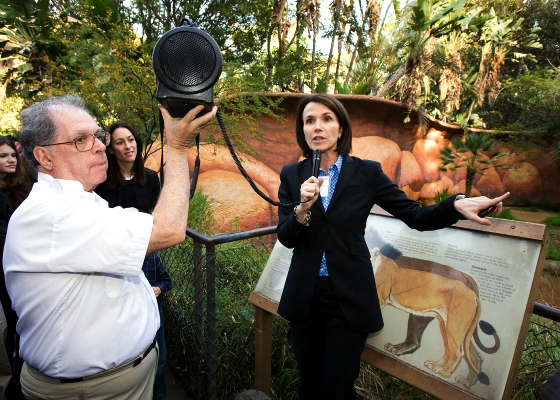A lion with a faulty heart, a rhinoceros suffering from skin cancer and a bull terrier showing signs of obsessive compulsive disorder were just a few of the cases physicians and veterinarians recently discussed over sack lunches and a bus ride to the Los Angeles Zoo and Botanical Gardens.
Doctors from the Ronald Reagan UCLA Medical Center and veterinarians from the UC Davis School of Veterinary Medicine came together at the Zoobiquity Conference on Jan. 29 to collaborate on diseases that affect both humans and animals.
The day began at the UCLA Medical Center, where doctors and veterinarians discussed their areas of specialization, from cardiology and dermatology to neurology and behavioral psychology.
The doctors compared similar cases found in humans and animals, including methods for curing brain tumors in Rhodesian Ridgeback dogs and separation anxiety in other breeds.
They then traveled to the Los Angeles Zoo, where they saw some of the animals that had benefited from joint efforts by human and animal doctors.
The group visited Cookie the lion, who had previously appeared sluggish and lethargic to zoo veterinarians.
With the help of UCLA physicians, her pericardium, the sack around her heart, was drained and she returned to health.
Then they saw Randa the rhino, who survived skin cancer that had developed around her horn; a condor saved from lead poisoning; and a monkey cured of pancreatitis.
The conference was a major step toward a closer relationship between human and animal medical professionals by bringing together some of the best doctors and veterinarians in the country, said Dr. Barbara Natterson Horowitz, a cardiovascular physician at UCLA and one of the organizers of the event.
Both humans and animals will benefit from a closer relationship among their doctors, said Dr. Curtis Eng, the chief veterinarian at the Los Angeles Zoo.
“Vets have such a wide range of species we must be prepared to help, more than 300 for zoo vets,” he said.
The array of animals they must care for, from 13,500-pound elephants to one-gram poison arrow frogs, means sacrificing some degree of specialization, he said.
“Veterinarians, therefore, receive tremendous help from the super specialization that is required from human doctors,” Eng added.
Human doctors, similarly, will benefit from a broader understanding of the diseases that affect people, Natterson Horowitz said.
“After speaking with veterinarians, doctors have told me they are taking different approaches to diagnosing and treating their own patients,” she said. “They are using techniques used in certain veterinary procedures, and they have a better understanding of these diseases.”
Though they undergo training in comparative anatomy and zoology in medical school, doctors are still amazed when they see similarities in human and animal conditions, Natterson Horowitz said.
“I became fascinated when I would see a human heart disorder in the morning, and then in the afternoon I would be seeing the same condition in an image of a chimpanzee’s heart, which is basically identical,” she said.
One of the most promising aspects of the conference was the development of the Zoobiquity Research Initiative, said Cheryl Scott, a veterinarian at UC Davis and one of the organizers of the event.
The program will pair UCLA medical students with veterinary students from UC Davis to research health problems found in both humans and animals.
“We have some incredible proposals already,” she said. “The project has just begun, but we have already seen a lot of enthusiasm from both sides of the aisle.”
Some of the proposed topics for research include the proven relationship between obesity in dogs and their owners, and the similar treatments for high blood pressure in humans and giraffes, Scott said.
After the success of this year’s event, next year’s Zoobiquity Conference is already being planned, and the findings from the research projects will be presented there, Natterson Horowtiz said.
She added that the enthusiasm for the event shows the growing interest for a “species-spanning” approach to medicine.
“We share the same environment, largely the same genetics, and ultimately many of the same threats to our survival,” Natterson Horowitz said. “The time has never been more urgent, and I’m thrilled veterinarians and human doctors are coming together to span this largely imaginary species divide.”
